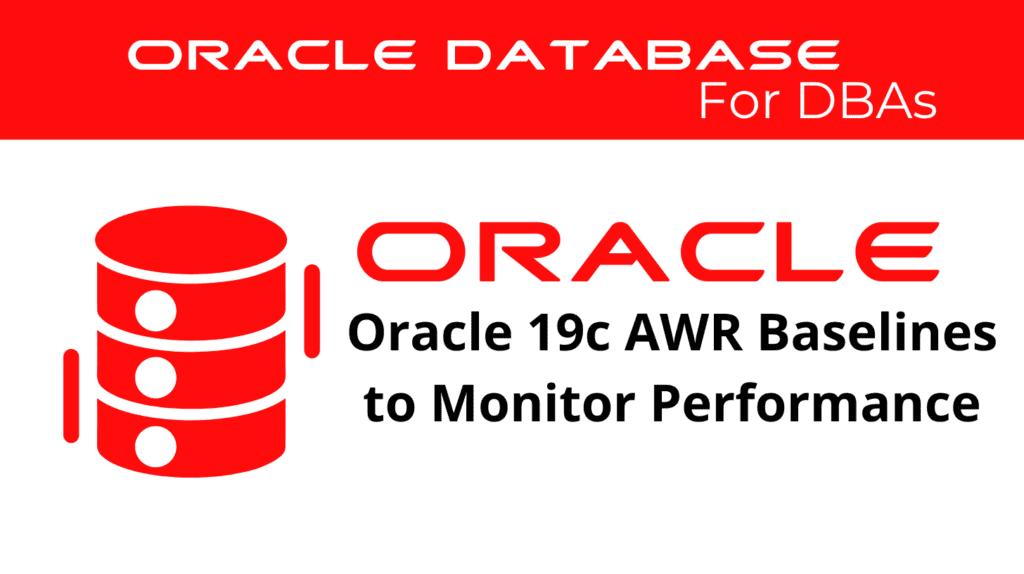
In Oracle 19c, using Automatic Workload Repository (AWR) baselines is essential for monitoring performance. AWR Baselines helps ensure optimal database performance by providing a reference for comparison. We will explore the creation, management, and use of AWR baselines to monitor performance effectively.
What are AWR Baselines Monitoring?
AWR baselines are predefined performance metrics captured over a specific period. They serve as reference points for comparing current database performance against historical data. Establishing these baselines is crucial because they help identify performance trends and anomalies.
To create an AWR baseline, determine a representative time period during which the system was performing optimally. This period will serve as a benchmark for future performance comparisons. The baseline can be either a static snapshot or a moving window, depending on your monitoring needs.
AWR Baselines Monitoring – Creating Baselines
AWR Baselines – Creating AWR baselines in Oracle 19c involves a few steps. First, identify the period you want to capture as your baseline. This period should reflect the typical workload and performance characteristics of your system. Once identified, use the DBMS_WORKLOAD_REPOSITORY package to create the baseline.
For example, to create a baseline:
BEGIN
DBMS_WORKLOAD_REPOSITORY.CREATE_BASELINE (
start_snap_id => 100,
end_snap_id => 110,
baseline_name => 'Optimal_Performance'
);
END;
In this example, the baseline named ‘Optimal_Performance’ is created using snapshots 100 to 110. This baseline can now be used to monitor current performance against past optimal performance.
📢 You might also like: Oracle 19c Diagnosing Performance Issues using ADDM (Category: Performance Management and Tuning)
Managing Baselines
AWR Baselines Monitoring – Managing AWR baselines involves updating, maintaining, and purging baselines as needed. Regularly updating baselines ensures that they remain relevant and reflective of current workloads. You can update a baseline by creating new snapshots and incorporating them into the existing baseline.
To drop an obsolete baseline, use the following command:
BEGIN
DBMS_WORKLOAD_REPOSITORY.DROP_BASELINE (
baseline_name => 'Old_Performance',
cascade => FALSE
);
END;
This command removes the ‘Old_Performance’ baseline, helping maintain an organized repository.
Using AWR Baselines for Performance Checking
Once you have created and managed your AWR baselines, you can use them for performance monitoring. AWR baselines allow you to compare current performance metrics against historical data, enabling the identification of performance issues and trends.
Oracle Enterprise Manager (OEM) provides a graphical interface for AWR baselines monitoring. It allows you to visualize performance trends, compare different time periods, and generate reports. By regularly reviewing these reports, you can proactively address potential performance issues before they impact the system.
For example, to generate a performance report using a baseline, navigate to the Performance page in OEM, select the desired baseline, and generate the AWR report. This report will highlight deviations from the baseline, providing insights into areas that may require optimization.
Benefits of Monitor AWR Baselines
AWR Baselines Monitoring offers several benefits for database performance management:
- Proactive Monitoring: By comparing current performance with historical baselines, you can proactively identify and address performance issues.
- Trend Analysis: Baselines enable the analysis of performance trends over time, helping in capacity planning and resource allocation.
- Benchmarking: Establishing baselines allows for benchmarking against past optimal performance, ensuring that performance standards are maintained.
- Anomaly Detection: Deviations from the baseline can indicate potential issues, allowing for timely intervention and resolution.
Conclusion
In conclusion, AWR baselines are a powerful tool for monitoring database performance in Oracle 19c. By creating, managing, and utilizing these baselines, you can ensure that your database operates efficiently and effectively. Implementing AWR Baselines Monitoring not only helps in maintaining optimal performance but also provides valuable insights into performance trends and anomalies.
Leveraging the full potential of AWR baselines requires regular updates and reviews, ensuring that the baselines remain relevant and useful for performance monitoring. Start implementing AWR baselines in your Oracle 19c environment today to enhance your performance monitoring capabilities.
See more on Oracle’s website!
Be Oracle Performance Management and Tuning Certified Professional, this world is full of opportunities for qualified DBAs!





